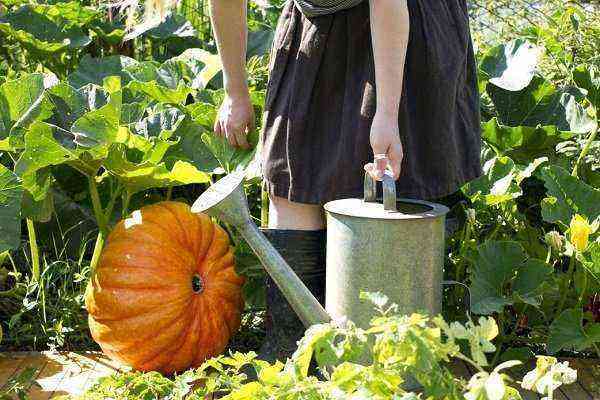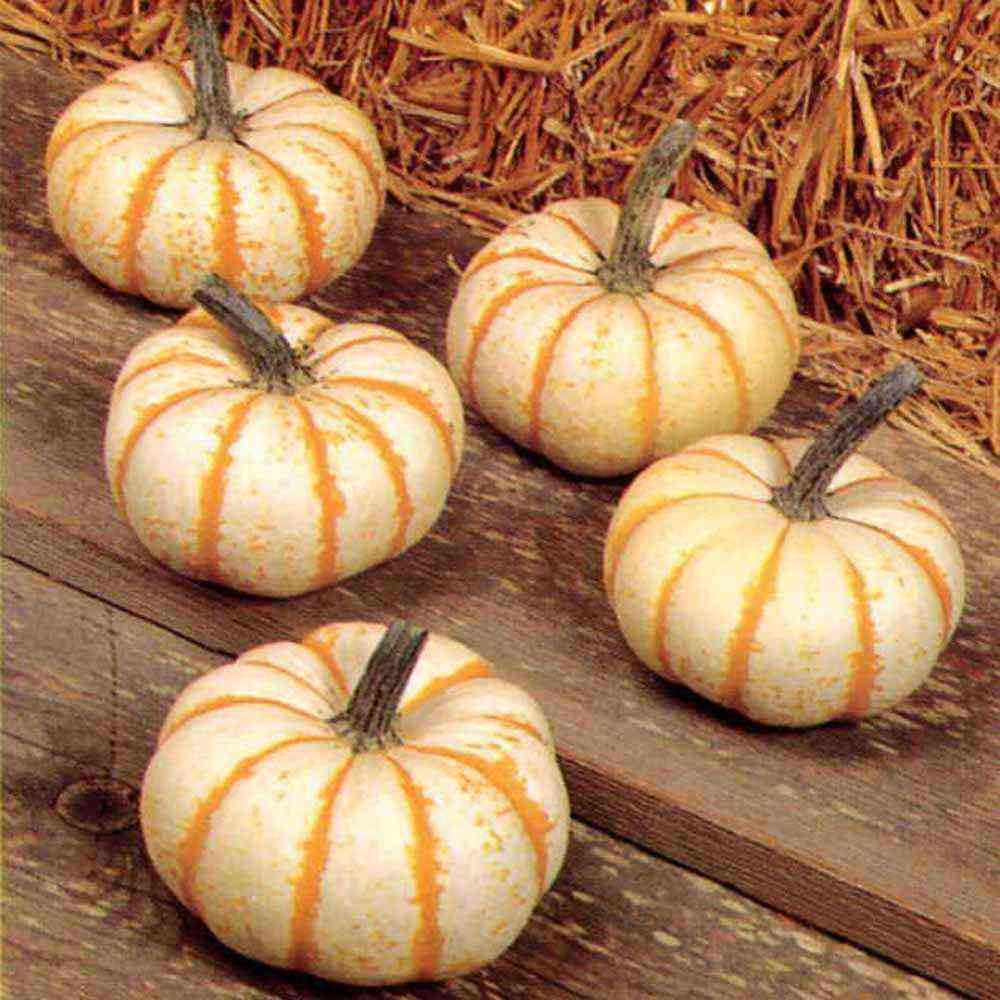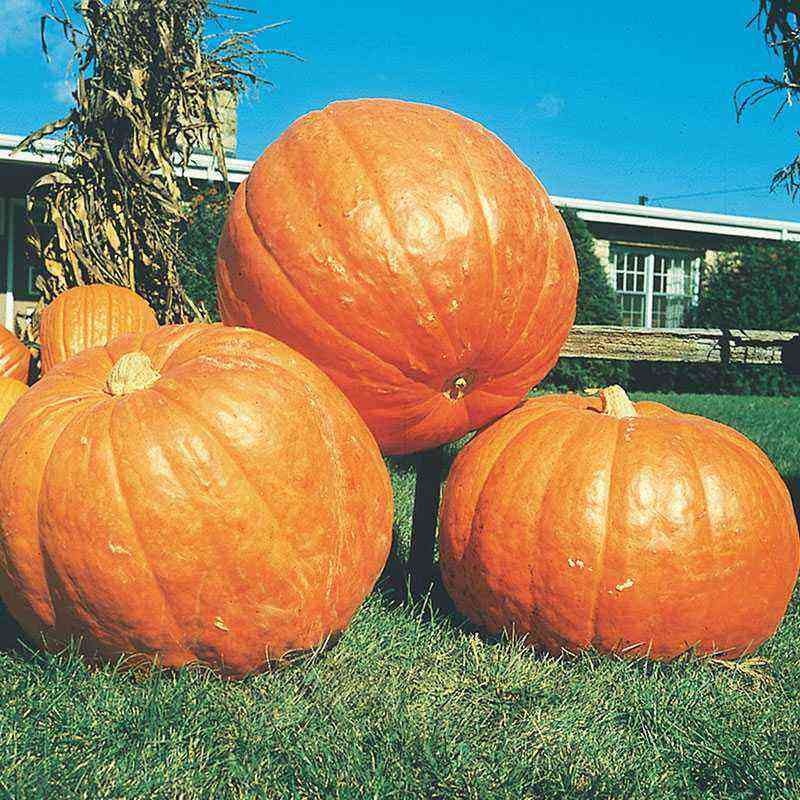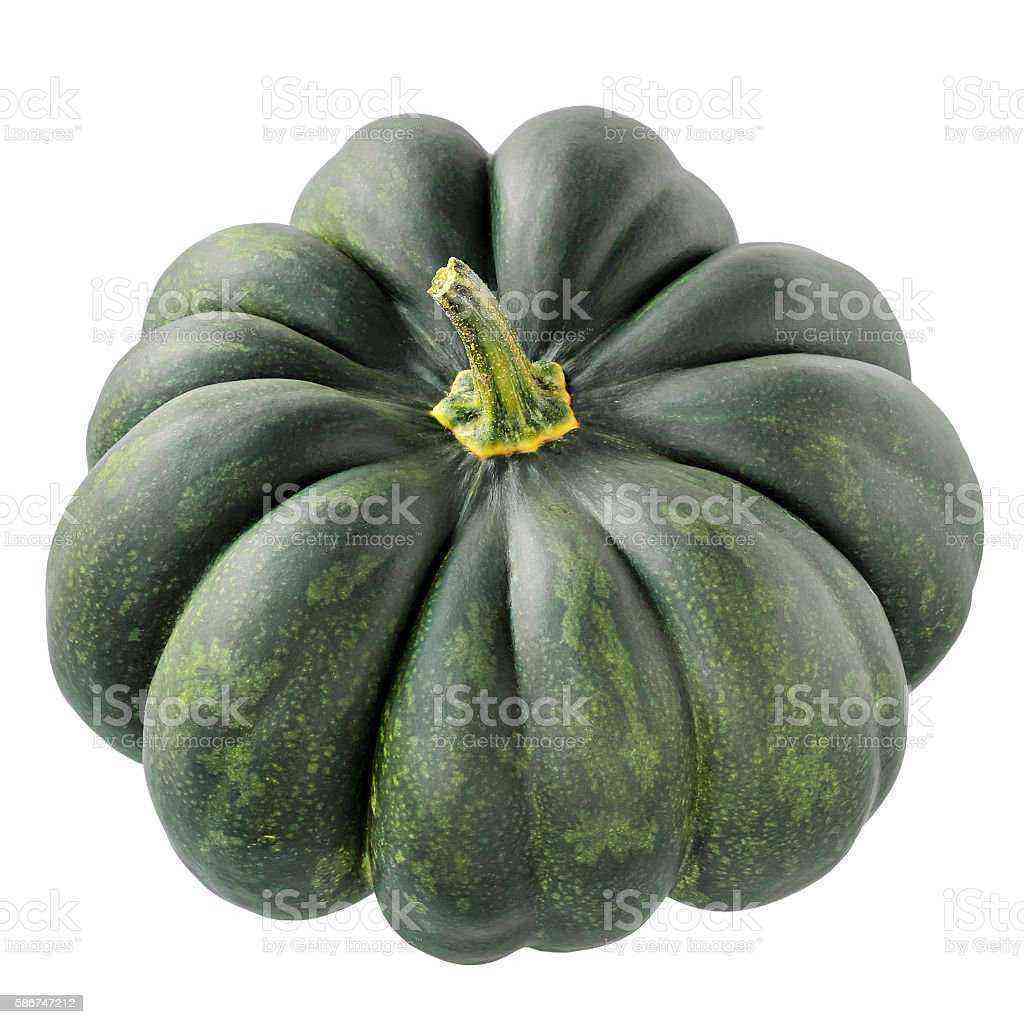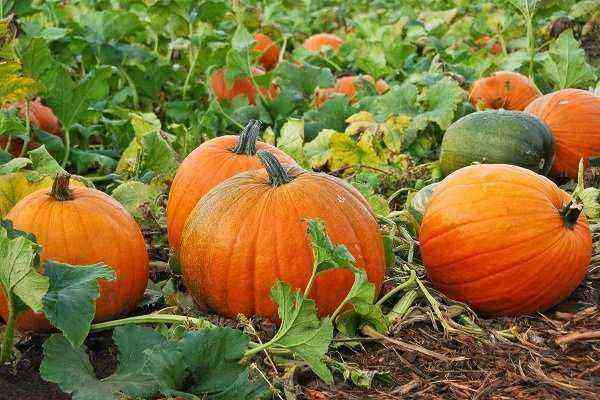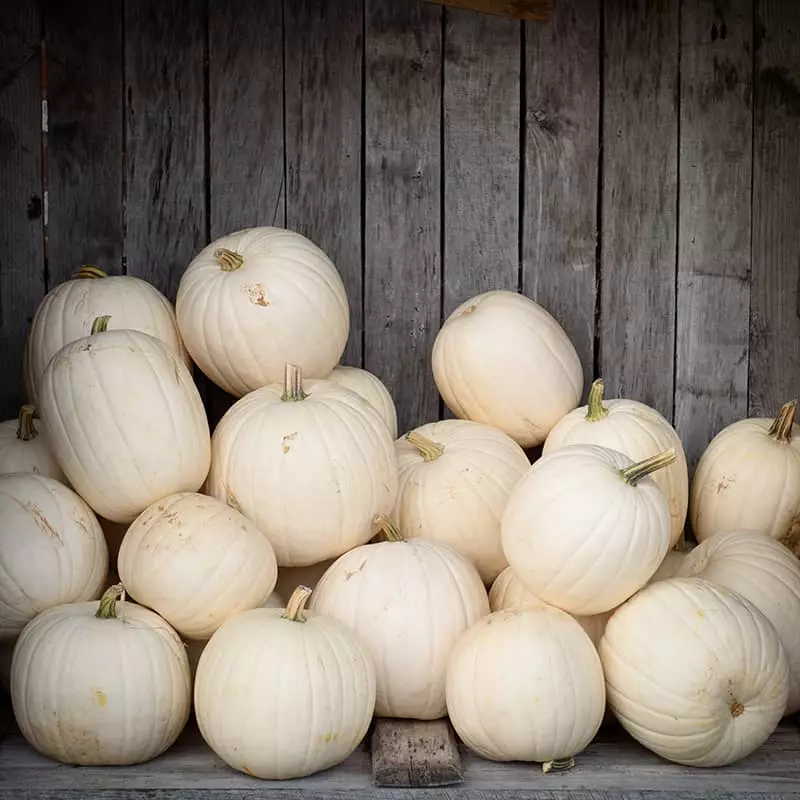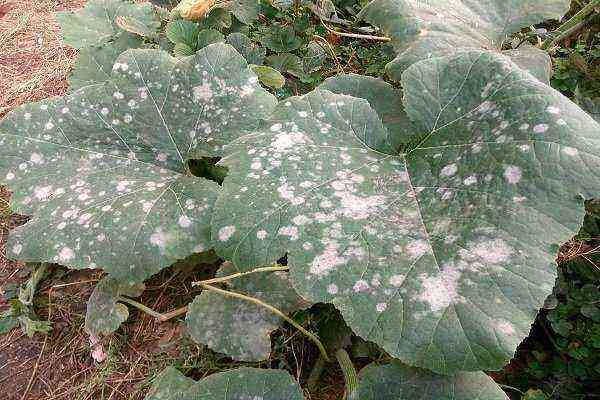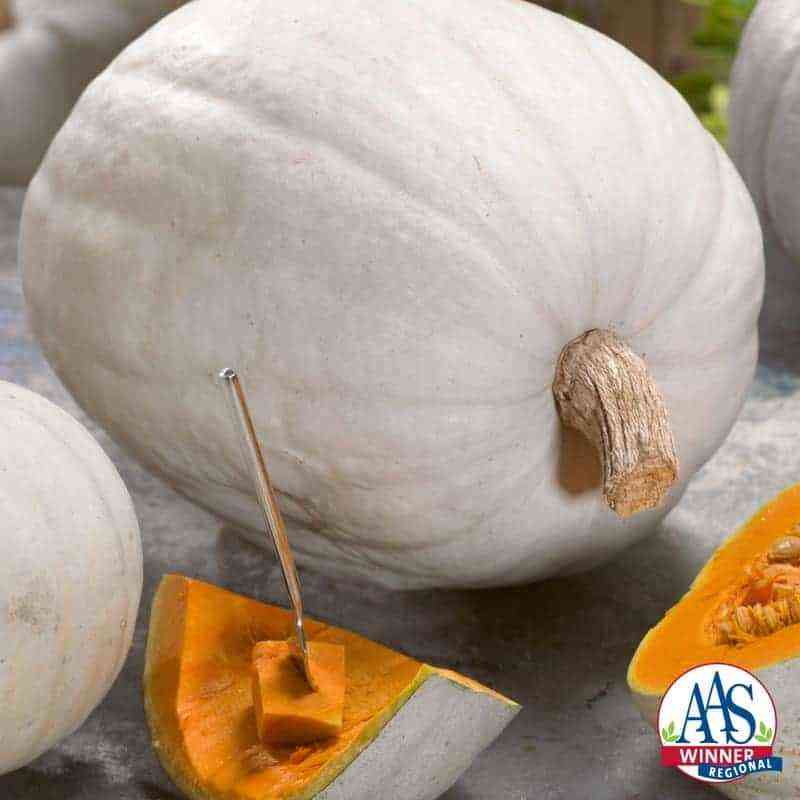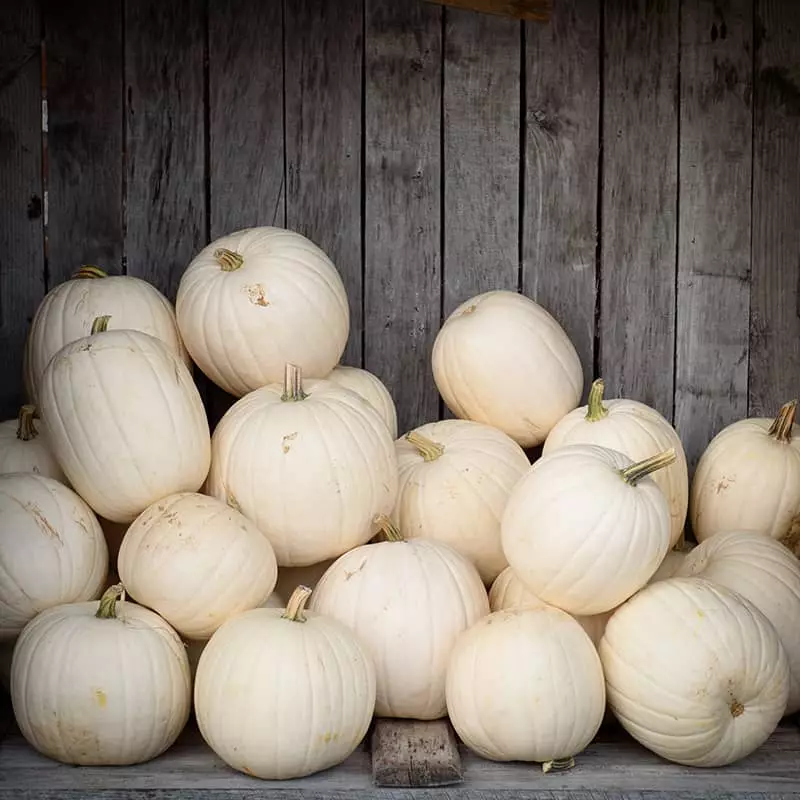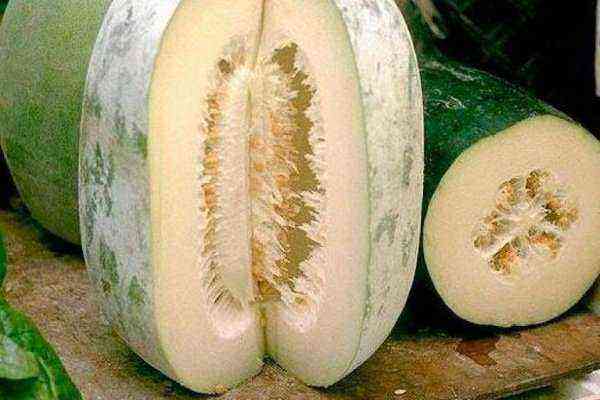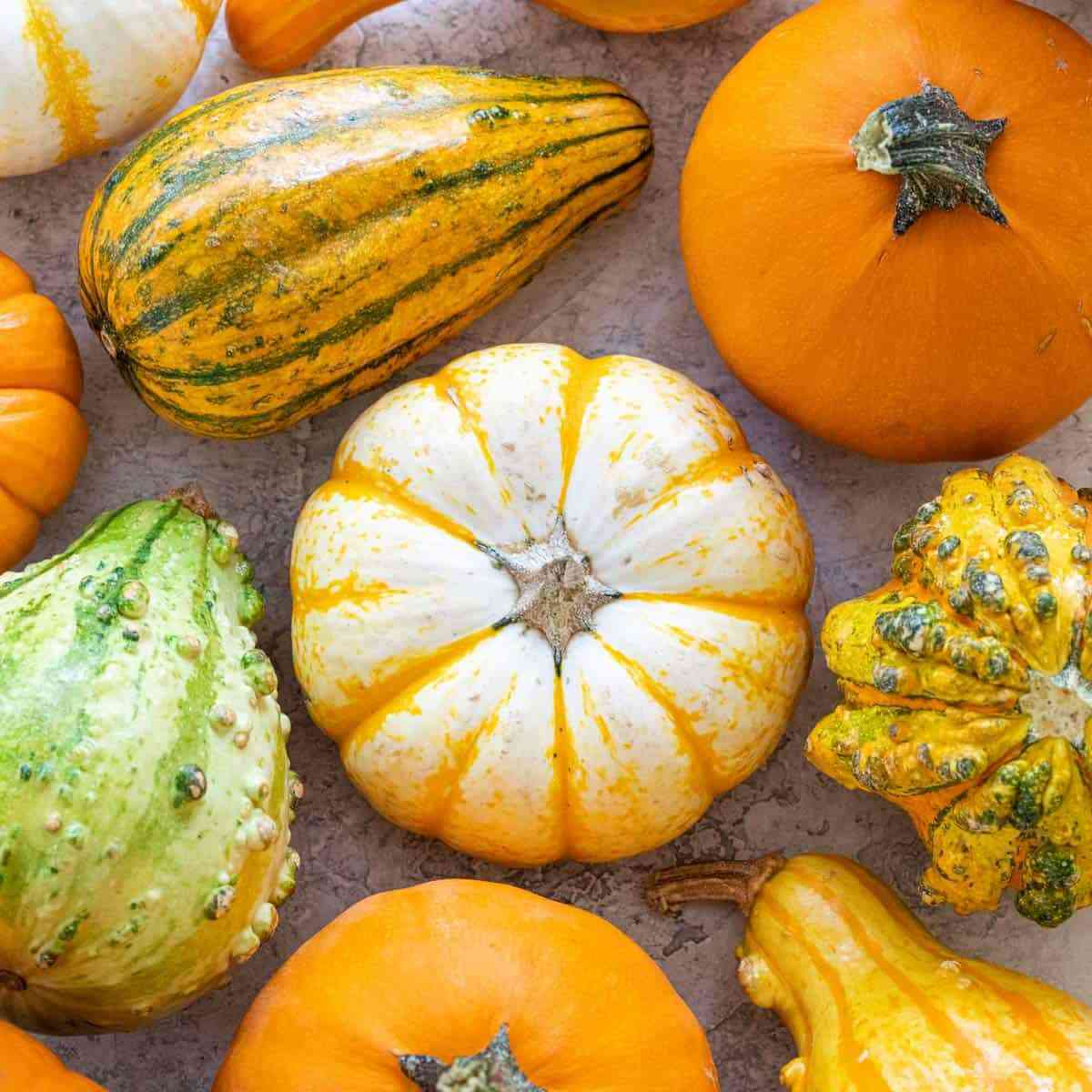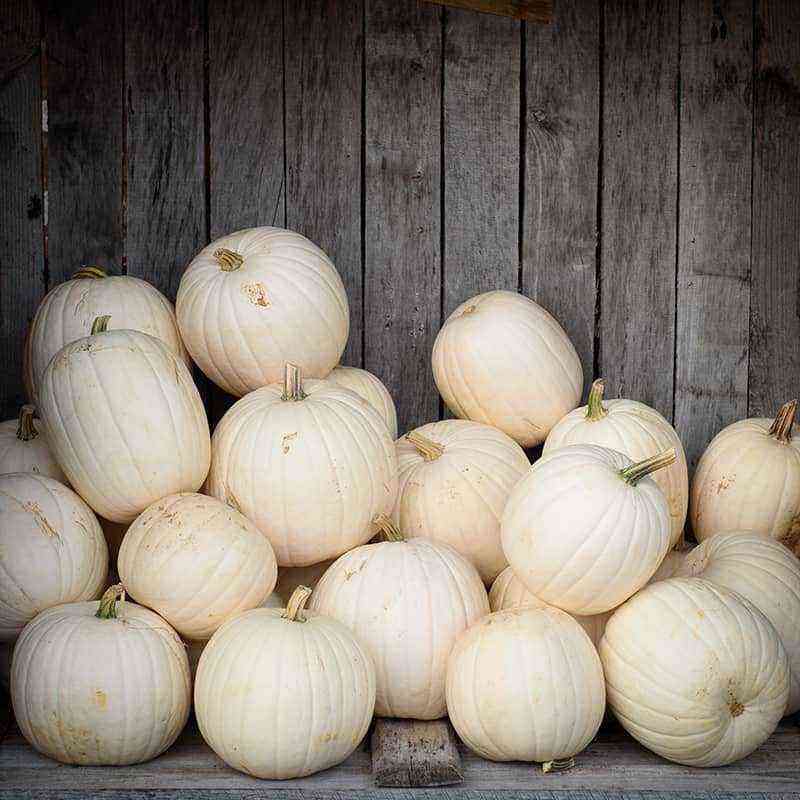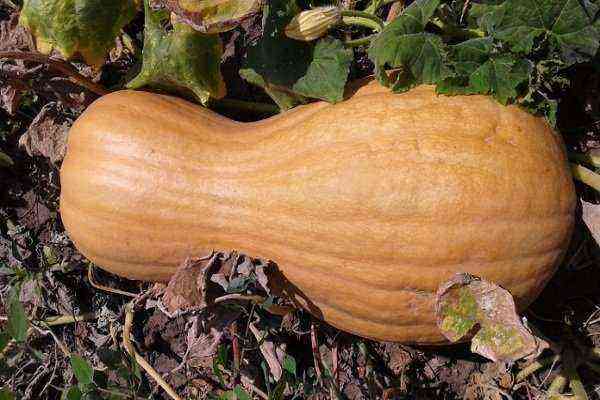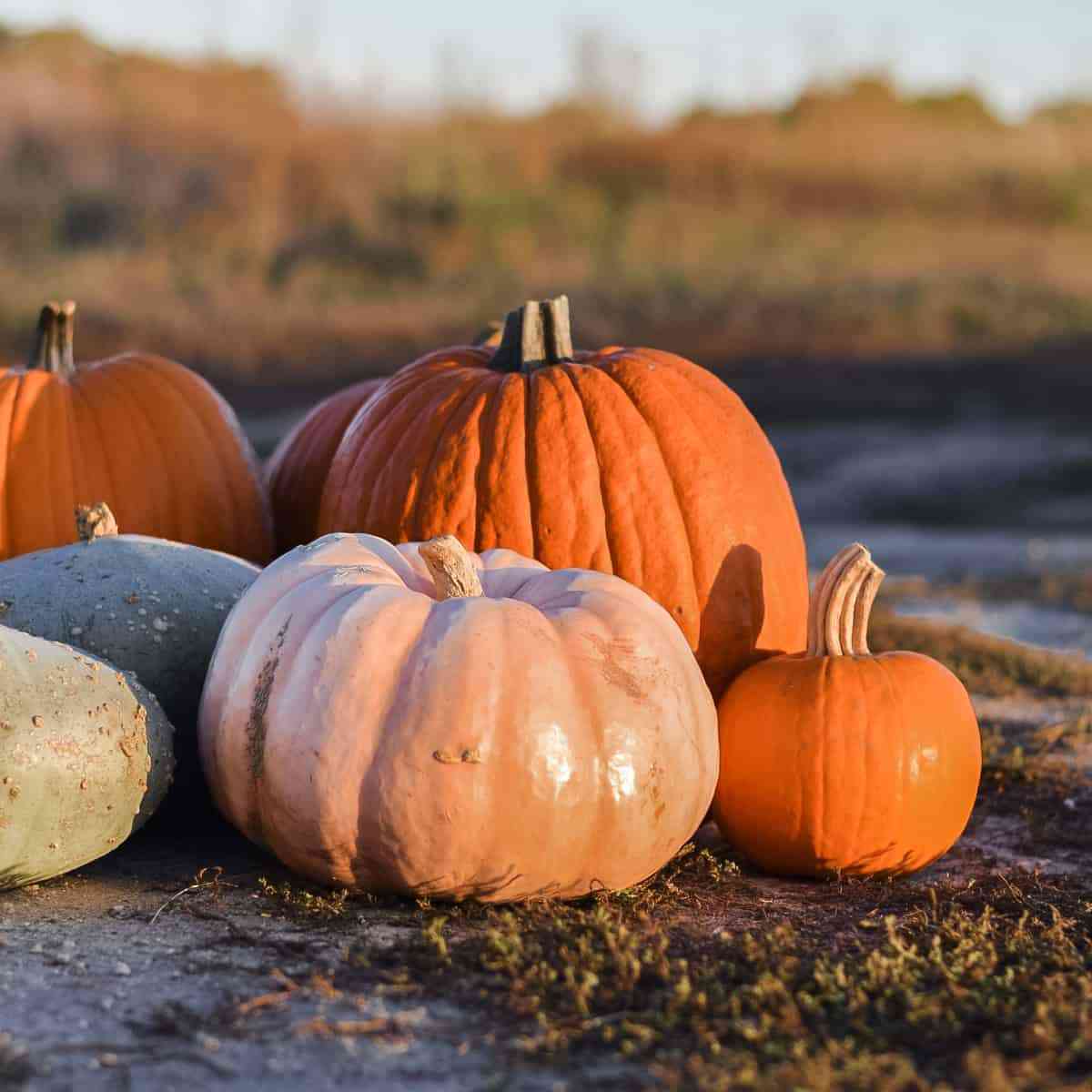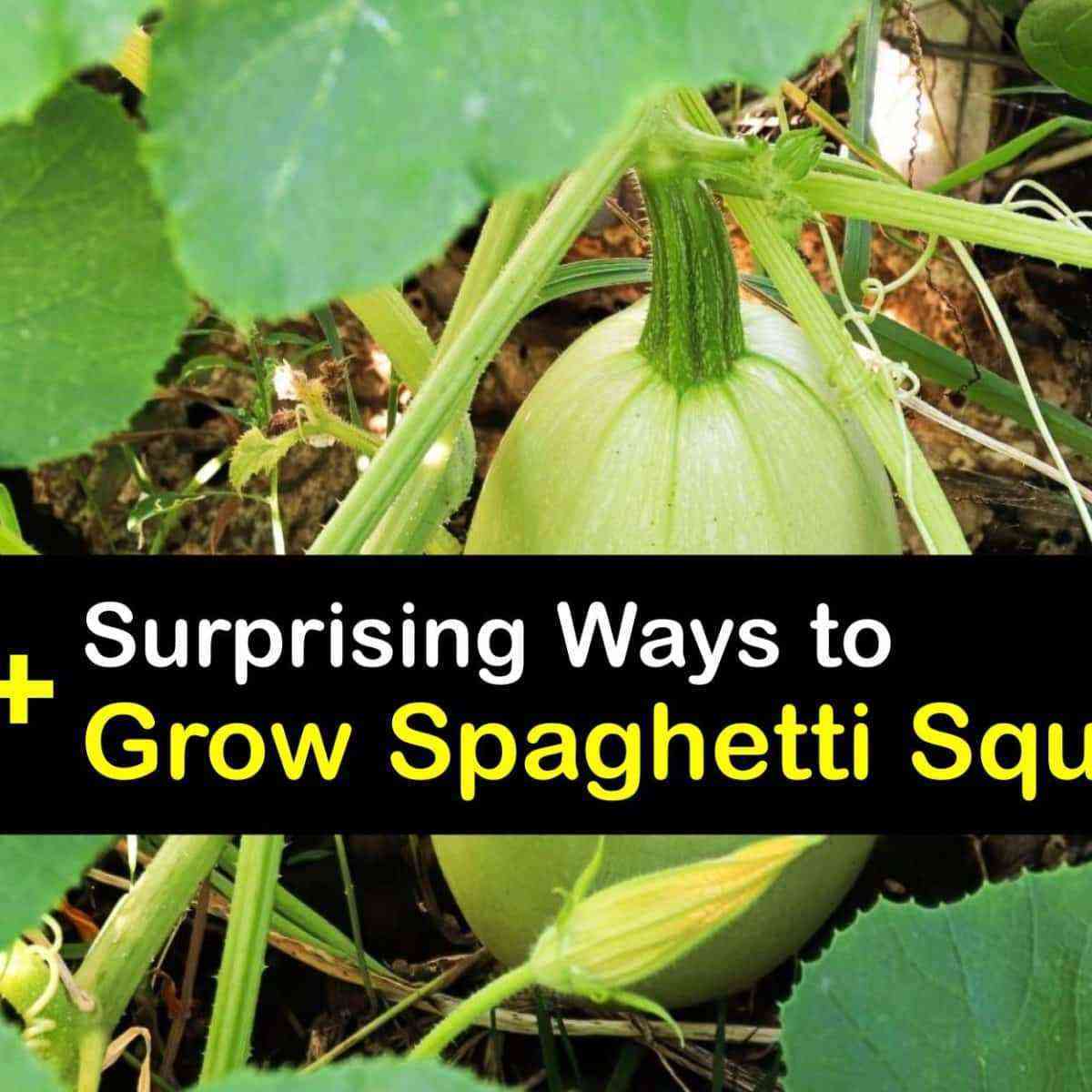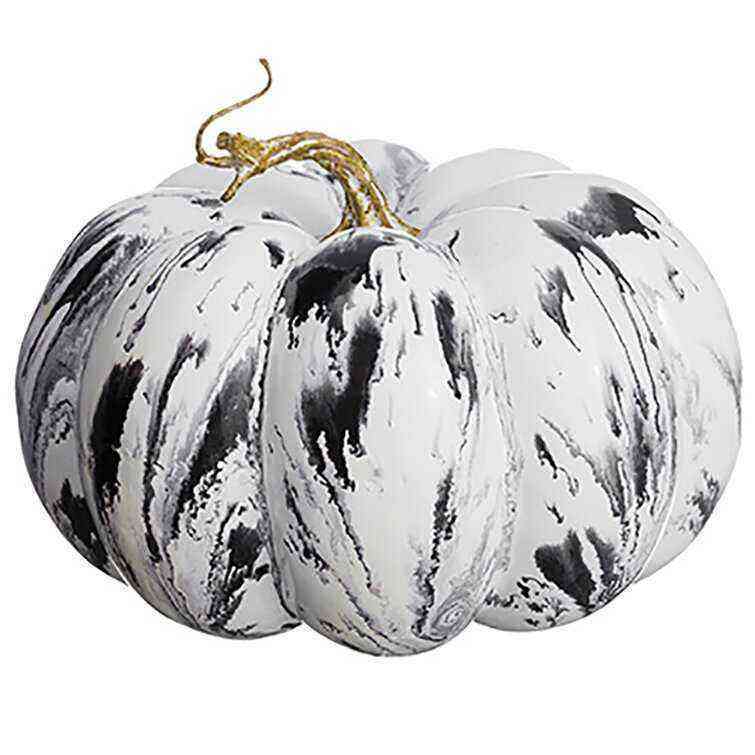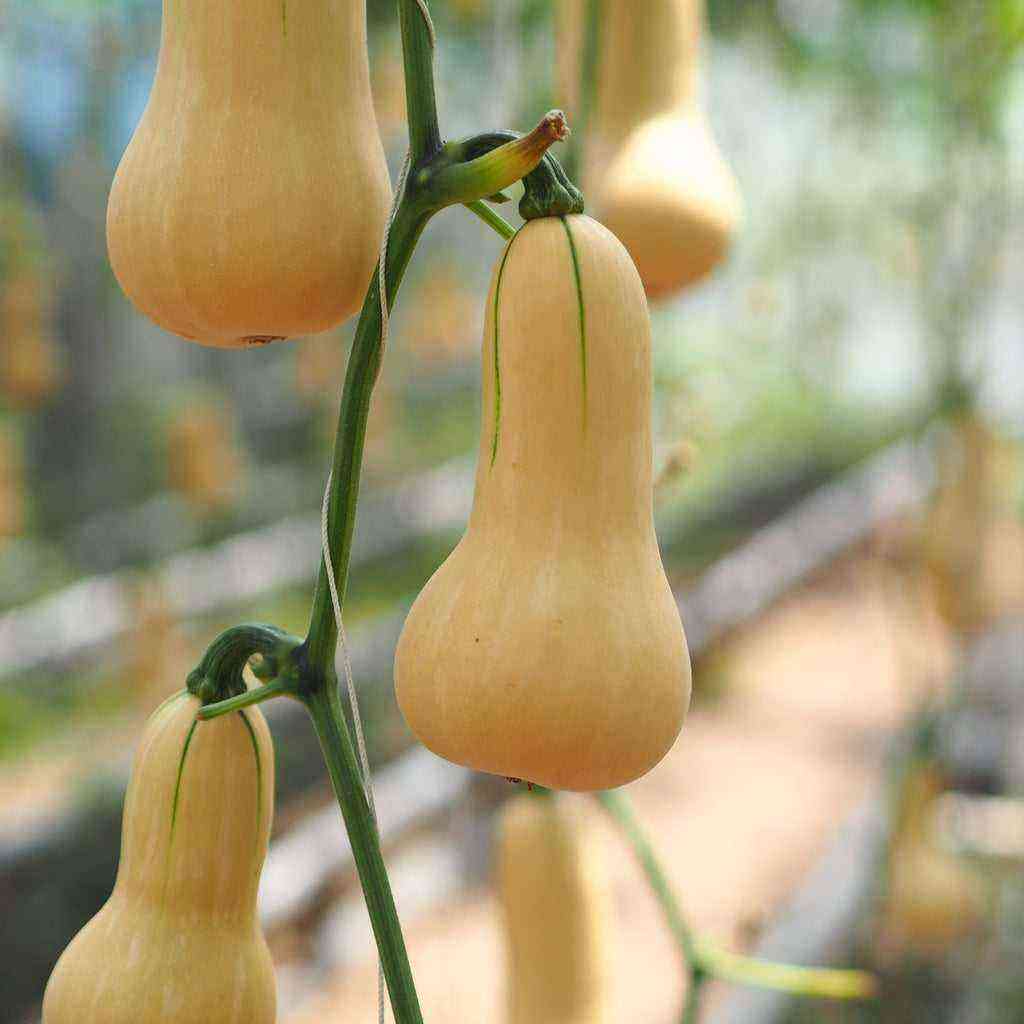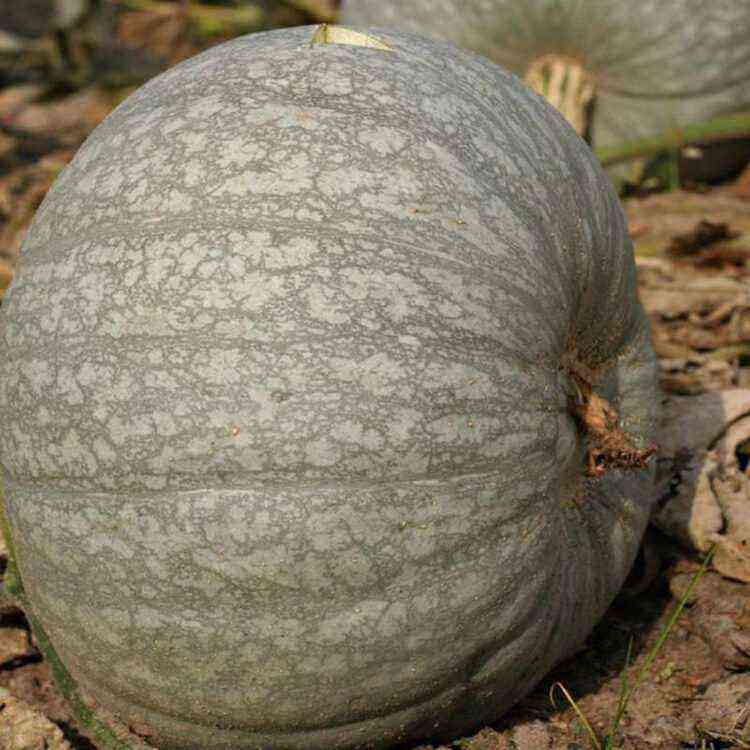There are a lot of pumpkin varieties, but all edible fruits are conventionally divided into three groups – hard-barked, large-fruited and nutmeg. It is believed that the nutmeg pumpkin has the most delicious pulp, which is distinguished by a mild nutmeg aroma, thin skin and a record level of sugar content (up to 15%). What varieties belong to nutmeg pumpkins and how to grow them, we will find out further.
What is this pumpkin?
Butternut squash or moskhata is a plant of the pumpkin family, whose homeland is America. It differs from other types of pumpkins in the following properties:
- refers to late-ripening varieties, therefore, due to lack of heat, when grown in the middle lane, it may not produce any fruits, or even ovaries;
- fruits can reach huge sizes, up to 100 kg;
- the shape of the fruit is usually not round, but oblong, and resembles a zucchini, which is somewhat narrowed in the middle and thickened at the place of flowering;
- the skin of the fruit is smooth or ribbed, has a bright orange or yellowish-brown color and green longitudinal stripes, but is very thin, so it can be easily removed even with an ordinary knife;
- the fruits have a relatively small family nest, but contain a lot of orange-colored juicy fibrous pulp, which has a sweet taste and a slight nutmeg smell.
Muscat pumpkin occupies a leading position in its family in terms of taste.
Energy value and composition
Butternut squash is a versatile dietary product that is easily absorbed by the body. 100 g of pulp contains up to 45 kcal, and the energy value of the product is as follows:
- proteins – 1 g;
- fats – 0,1 g;
- carbohydrates – 9,69 g;
- dietary fiber – 2 g;
- water – 86,41 g.
It is important to note that the fruits contain only polyunsaturated fats, that is, they do not contain cholesterol.
Pumpkin is also valued due to the content of a large amount of vitamins, mineral salts, pectins and carotene, which is 2-3 times more than in the same carrots.
What kind of vitamins are present in the fruits of a heat-loving plant can be seen in the table:
Vitamin
Content
B1 (thiamine)
0,1 mg
B2 (riboflavin)
0,02 mg
B3 (niacin equivalent, vitamin PP)
1,2 mg
B5 (pantothenic acid)
0,4 mg
B6 (pyridoxine)
0,15 mg
B9 (folic acid)
27 μg
C (ascorbic acid)
21 mg
K (phylloquinone)
1,1 μg
E (alpha tocopherol)
1,44 mg
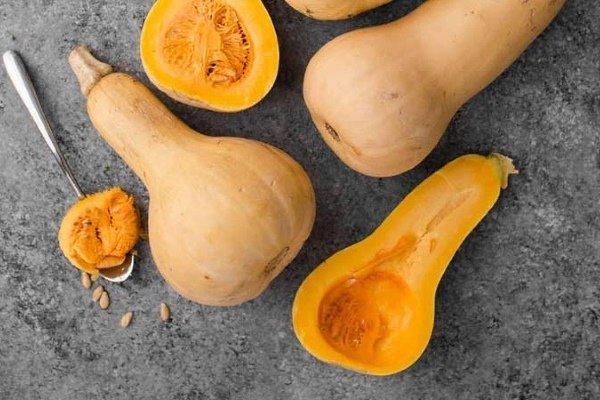
Pumpkin contains no less amount of minerals, a list of which is presented in the following table:
Mineral substance
Content
Hardware
0,7 mg
potassium
352 mg
Calcium
48 mg
Magnesium
34 mg
Manganese
0,2 mg
Copper
0,07 μg
Sodium
4 mg
Selenium
0,5 μg
Phosphorus
33 mg
Zinc
0,15 mg
Useful Properties
Due to its rich composition, with regular use, nutmeg has a positive effect on the human body:
- cleanses the body of toxins, cholesterol and decay products, helps in getting rid of body fat (for this reason, pumpkin can be safely included in the diet in the fight against obesity);
- normalizes metabolism and supports the work of the organs of the gastrointestinal tract;
- strengthens the immune system, saturating the body with vitamins and nutrients;
- has a choleretic and diuretic effect, helping to remove salts of heavy metals (in this regard, pumpkin is recommended for use in diseases of the liver and kidneys);
- improves the condition in diseases of the urinary system, including helping to dissolve stones in the bladder;
- increases visual acuity due to the content of a large amount of carotene;
- slows down the aging process with regular eating, as it saturates the body with vitamin K;
- prevents diseases of the cardiovascular system and has a positive effect on the state of blood vessels and blood, since it contains potassium (for this reason, pumpkin helps to get rid of anemia);
- relieves inflammation in the liver and prostate gland.
To get the benefits of pumpkin, it can be consumed stewed, baked, boiled, and even raw. For medicinal purposes, it is recommended to drink 1/3 cup of pumpkin juice or a decoction of the shoots of the plant several times a day.
Nutmeg pumpkin cannot be included in the diet in only one case – with individual intolerance.
The best varieties of nutmeg pumpkin
The nutmeg pumpkin group includes many varieties that may differ in shape, size, ripening period and many other parameters. The most popular varieties include the following varieties of nutmeg pumpkin:
Vitamin
The growing season is about 130 days, so it is considered a late ripening crop. Fruits grow on a long lash, which have a wide oval or cylindrical shape and weight from 4,5 to 6,8 kg. The skin is thin, and the thickness of the edible bright orange part reaches 10 cm. It has a characteristic brown color and is covered with small patches of yellow and green hues. The pulp has a sweetish taste and a crispy, but delicate texture.
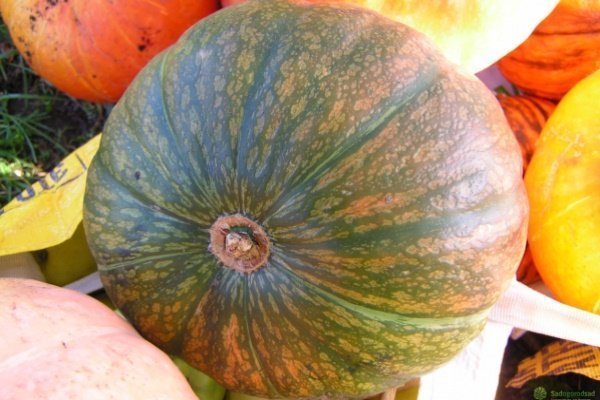
Prikubanskaya
The vegetation period is from 91 to 136 days. The fruit is pear-shaped and weighs an average of 2,3 to 4,6 kg. The thickness of the pulp is about 4 cm, and the peel is thin, and on the cut it has a creamy hue. The flesh is red-orange, tender and sweet, but closer to the stem it is solid and dense. You can store pumpkin after harvest for three months. The variety was bred at the Krasnodar All-Russian Research Institute of Rice.
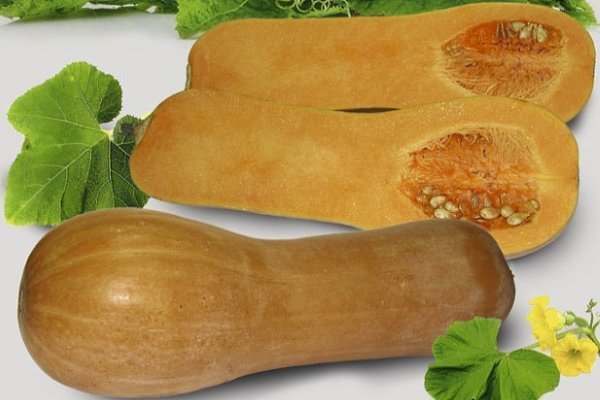
New
The growing season is about 110-115 days. The fruits are elongated-cylindrical or pear-shaped, and slightly expanded at the flower part. Their weight can reach 5-6 kg. The skin is thin, orange in color and covered with dark orange spots and stripes. The pulp is medium density, sweet and juicy. On average, the yield of the variety is 50-70 t/ha. The novelty has a high keeping quality – 6-8 months.
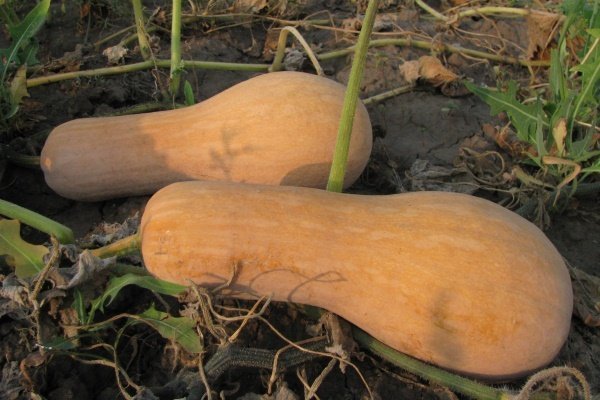
Bylinka
The vegetation period is 115-120 days. The weight of the average fetus is 4-4,8 kg. Productivity – 25 t/ha. Unlike many of its counterparts, Bylinka has a dense skin from light gray to dark gray (corrected in the process of full maturation). The pulp is traditionally bright orange in color, thick, dense, sweet and juicy, but without the characteristic pumpkin flavor. Pumpkin has a long shelf life – until the next season. The variety was bred by the Kherson breeder “South GSOS”.
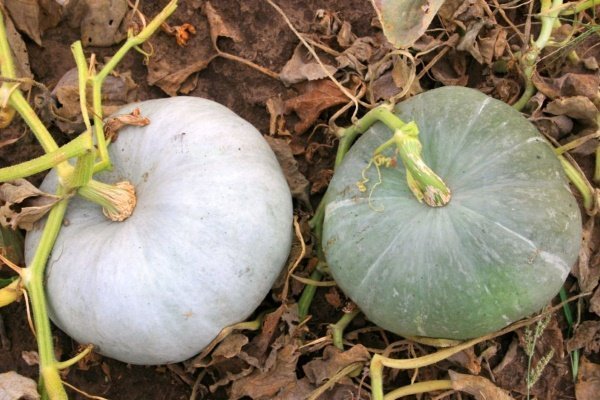
Pearl
The growing season averages 115-130 days. The fruits weigh about 2,6-5,6 kg, and reach a length of 50 cm. Their shape is round-cylindrical, but there are round or oval pumpkins that have a pronounced ribbed structure. The peel is thin and bright orange in color, but during ripening the shade can change from gray-green to greenish-orange. The flesh is thick and juicy, with a characteristic orange-yellow tint. The plant itself is quite powerful – it gives 4-7 lateral lashes.
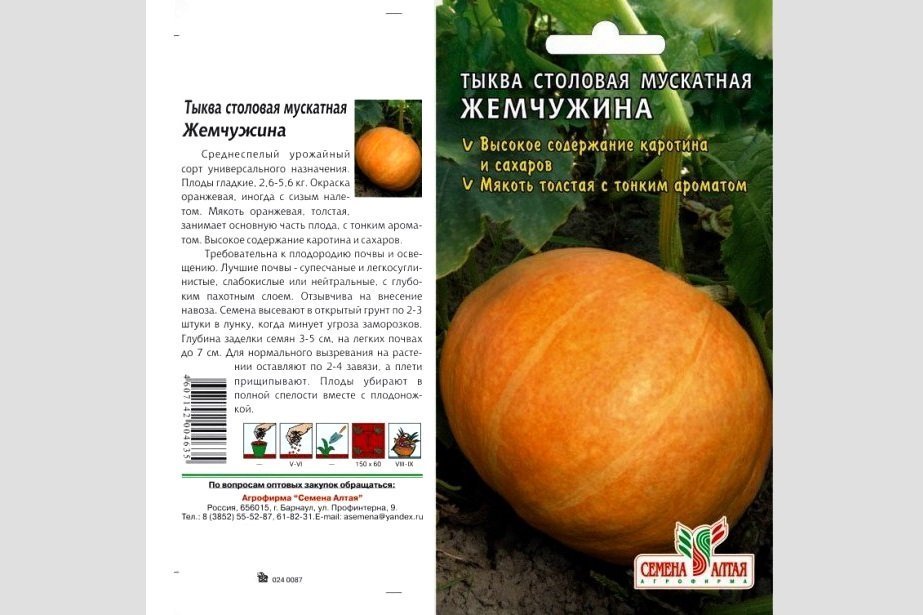
Muscat de Provence
The vegetation period is 110-115 days, so the variety is medium late. The mass of fruits averages 4 kg, but can reach up to 8 kg if the seeds are sown at a great distance from each other and the soil is properly fertilized. The fruits are round and slightly flattened. The skin is orange-brown, thin and ribbed. The pulp is sweet and fragrant, containing a lot of sugar and carotene. The variety of French breeders must be stored for 4 months, as it is resistant to many diseases.

Guitar
The vegetation period lasts from 110 to 120 days. The fruits are elongated, resembling a guitar. Their weight averages 2-4 kg, but sometimes it can reach 8 kg. The length of one pumpkin is about 70-80 cm, but on fertile soils it can reach up to 1 m. The skin is thin and smooth, and when the vegetable ripens, it becomes a bright orange color. The pulp occupies about 90-95%, which favorably distinguishes this variety from others.
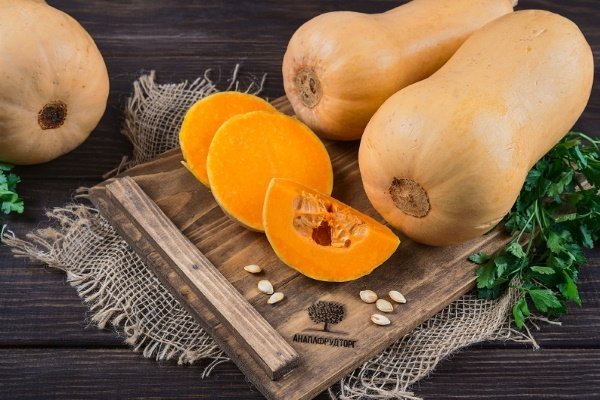
Trombone
The growing season is about 110 days. The fruits have an original twisted shape and a length of up to 50 cm, so they are often used to decorate suburban areas. On average, their weight is 6-8 kg, but with favorable soil it can reach 18 kg. The skin is dense and has an orange or green color. By the time of full ripening, the flesh becomes bright orange in color and becomes very fragrant. You can store pumpkin for more than a year. The variety was bred by Italian breeders and has several names – “pipe from Albenga” (Albenga is a city in Italy), “tromboncino” (small pipe) and “zucchetta”.

Chudo-Yudo
The growing season is up to 120 days. The fruits are oval in shape and weigh up to 6-8 kg. The skin is colored orange, has characteristic mesh patterns and a gray coating. The pulp has a bright orange color with red veins and can be eaten fresh, because it is very tasty – it has a high content of carotene (25,5%) and sugar (4,25%).
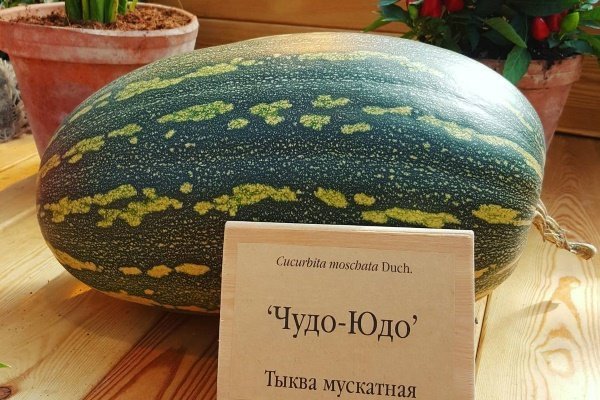
Barbara F1
The vegetation period is 50-60 days, therefore it is an early ripe universal hybrid that can be grown in different regions. If the pumpkin is planned to be stored, then it is better to collect it on the 85-90th day after the emergence of shoots. Fruits gain in weight about 2-6 kg, but with fertile soil, this figure can reach 15 kg. They are cylindrical in shape with a thickening at one end. The skin is orange, but covered with dark green longitudinal stripes. The pulp is sweet and tasty, of medium thickness and light color.

Peanut butter
The vegetation period is about 85 days, therefore it belongs to the early ripe varieties bred in Germany. The fruits acquire a pear-shaped shape and reach a weight of up to 4 kg. The skin has a pleasant cream color, and the flesh is bright orange. It tastes sweet and crunchy with a pleasant nutmeg-peanut flavor. The fruit can be stored for 6-12 months.

Nut Butter (“Butternut”)
The growing season is 125-130 days, so the variety is considered medium early. The pumpkin is portioned – gaining a mass of 500-700 g, and up to 30 fruits can grow on one plant. The variety is unique in that during the growth process, a piece can be cut off from the vegetable and used for its intended purpose, while the rest of it will not rot, but will be covered with a new peel and continue to grow. The pumpkin is pear-shaped and creamy-beige in color. The pulp itself is bright orange in color, dense, oily and gives off a bright nutty flavor. The variety was bred by the Massachusetts Agricultural Experiment Station by crossing wild African and nutmeg gourds.
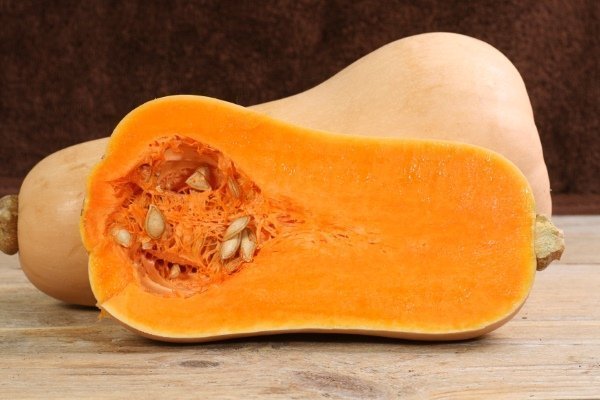
Many varieties of butternut squash are thermophilic, but you can also pick up universal specimens that are adapted to colder climates, for example, the early-ripening hybrid Barbara F1.
Ways of planting
Butternut squash is planted mainly in seedlings, which is especially important in the cool conditions of the middle lane. If the plant is grown in a tropical, subtropical or subequatorial zone, then planting can be done directly in open ground. Each method should be considered separately.
Planting through seedlings
Experienced farmers prefer to grow pumpkin through seedlings, regardless of the temperature of the region. The first days are extremely important for the formation of taste qualities in future fruits, so it is extremely important to exclude the possible impact of negative weather conditions. In addition, when growing pumpkins through seedlings, you can speed up the process of obtaining fruits.
It is necessary to prepare seedlings according to the usual rules of agricultural technology 20 days before transplanting into open ground, that is, in April or May. You need to act as follows:
- Seed preparation. Soak the seeds for 3-4 hours in hot water (about 45°C), then wrap them in a damp cloth and keep at room temperature until they peck (usually this will take 2-3 days). Such preparation will accelerate the germination of seeds and protect them from pests. When growing butternut squash, experienced gardeners also recommend hardening the seeds to increase their cold resistance. So, already pecked pumpkin seeds should be kept for 3-5 days in the same damp cloth on the lower shelves of the refrigerator. Pre-seeds can be sprinkled with ash as a microfertilizer.
- Capacity selection. Pumpkin seedlings do not tolerate transplanting well, so it is recommended to plant the seeds in separate peat pots at least 6×6 cm in size. Some gardeners grow seedlings in homemade paper pots. They can be easily cut without harming the root system of the plant. In extreme cases, you can use ordinary wooden boxes.
- Substrate Preparation. To prepare the soil mixture for seedlings, you should mix 2 parts of peat, 1 part of rotted sawdust and humus. For 1 kg of substrate, add 1 tsp as a fertilizer. nitrophoska. Mix the mixture thoroughly. It should be noted that the gardener can immediately purchase ready-made soil from the store – a universal vegetable or one that is recommended for cucumbers.
- Seed sowing. Fill the pots with the substrate, and then water them abundantly and prepare small holes in which to drop the seeds. The optimal planting depth is 4-6 cm. If the seedlings are grown in boxes, the bottom of the container should be sprinkled with sawdust in a layer of 3-4 cm before filling the soil.
Containers with seedlings should be transferred to a well-lit window sill, preferably south. In this case, you can grow strong seedlings without additional illumination. It is equally important to provide competent care for pumpkin seedlings, which is as follows:
- before germination, cover the surface of containers with seedlings with glass or film to create a greenhouse effect with a daytime temperature of + 18 … + 25 ° C and a night temperature of + 15 … + 18 ° C;
- after the emergence of seedlings, which occurs on about 6-7 days, reduce the daytime temperature to +15 … + 18 ° C and the night temperature to + 12 … + 13 ° C, and after 5-7 days raise it again, but not so intensively, as at first;
- regularly, but moderately water the seedlings to prevent either drying out or waterlogging;
- on the 7-10th day of germination, apply top dressing – nitrophoska (15 g per 10 l of water) or mullein solution (pour hot water over mullein in a ratio of 1:10, leave for 3-4 hours, dilute again in a ratio of 1:5 and water young plants );
- a week before planting in open ground, carry out hardening – gradually reduce the daytime temperature to + 15 … + 16 ° C and night – to + 13 … + 14 ° C.
Seedlings can be transplanted outdoors after the appearance of 2-3 true leaves of bright green color. By this time, the seedlings will grow to 15-20 cm. For their cultivation, you should choose areas where such crops previously grew:
- potatoes;
- beans;
- tomatoes;
- any kind of cabbage;
- bow.
The pumpkin cannot be transplanted into the soil in which its “relatives” like zucchini, cucumbers and melons previously grew. In addition, the site should be well lit by sunlight, be dry and warm, and also protected from the winds.
The transplant itself is carried out according to the following rules:
- Since autumn, dig up the beds and fertilize – per 1 sq. m add 3-5 kg of humus, 200 g of lime and 30-40 g of complex mineral fertilizers.
- In late May – early June, when the earth warms up to at least + 18 ° C, in cloudy weather or in the evening, prepare holes with a depth of at least 5 cm. The distance between them should be within 60-100 cm.
- If the seedlings were grown in peat cups, carefully destroy its dense outer walls. If the seeds were sown in boxes, the resulting seedlings should be taken out with a clod of earth so as not to harm the delicate roots.
- Plant young plants in prepared holes and pour plenty of water.
- Cover seedlings with foil to protect them from frost. When the temperature normalizes, the shelter can be removed, and then only used during cold nights.
A properly planted pumpkin produces large and heavy fruits, and 2-3 ovaries ripen on each plant.
Sowing in open ground
In warm southern regions, seeds can be sown immediately in open ground. It is worth doing this in the first decade of May under a film shelter. The optimum temperature for growing a crop is kept within + 20 … + 25 ° C.
Landing must be done on a well-lit piece of land, which is protected from shade and winds. It should be noted that if the soil is rich in groundwater, then it is not suitable for growing gourds, since its root system goes deep underground and can simply die from an excess of moisture.
The seeds prepared in the previously described way should be sown along the beds to a depth of 5-6 cm and at a distance of 80-90 cm. It is worth throwing 2 seeds into each hole, and when shoots appear, you will need to remove a weaker plant from the root.
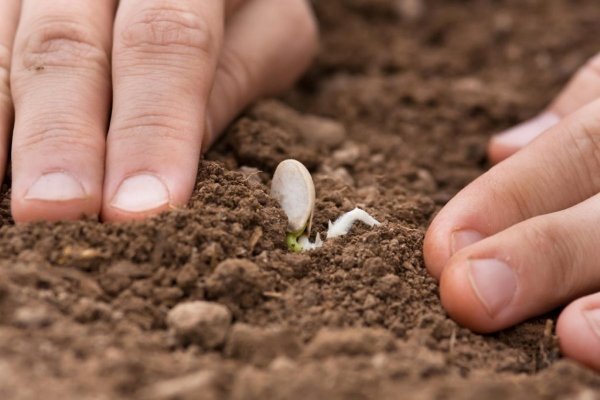
Butternut squash care
Regardless of the method of planting, the plant needs proper care, which involves the following activities:
- Watering and loosening. You need to water the pumpkin with plenty of warm water (about 20 ° C), and the optimal amount of water is up to 5-6 liters per plant or 15-20 liters per 1 sq. m of landing area. This is enough to give the pumpkin nutritional moisture, but to prevent cracking of the fruit. Before the formation of the ovaries, watering should be carried out once a week, and in the future – once every 2 weeks. After each watering, it is imperative to loosen the soil around the plants shallowly.
- Additional fertilizing. It helps to increase the yield of the variety and the quality characteristics of the fruit. The first fertilizing with nitrophoska is introduced after the formation of the 5th true leaflet on the plants. The second top dressing with a solution of mullein is introduced in the phase of lash formation. In addition, during the flowering period, the pumpkin can be watered with warm water with the addition of wood ash.
- Weed removal and pinching. Before the formation of lashes, it is extremely important to remove weeds in time. When the whips are formed, then the need for this will disappear. At the same time, it is not recommended to move the formed nodes and lashes, especially during the flowering period, since in this case the flowers can be damaged and the development of fruits can be suspended. It is equally important to remember to pinch the ovaries.
- Protection against pests and diseases. As a prophylaxis, the plant should be treated with biofungicides or growth-stimulating agents, which purely include Immunocytophyte, Krezatsin, Silk and Epin. In addition, bushes can be sprayed with Acrobat or Kurzat.
Despite preventive measures, pumpkin can be affected by various diseases and pests:
- powdery mildew. This is a disease that is provoked by a sharp change in day and night temperatures. Spots appear on the fruits, and the leaves turn yellow, dry out and fall off. To prevent powdery mildew, the plant should be covered with a film at night. It is equally important to water the plant abundantly and regularly.
- Anthrax. The disease often affects pumpkins that grow in a closed area or in a greenhouse. Less often, it poses a threat to plants grown in the open field. Anthracnose is manifested by a symmetrical lesion of the leaves, and after the stem and fruits. On the surface, ulcers are formed, covered with a pink coating. The plant dies completely when the disease affects the root. Anthracnose develops with excessive humidity. In addition, it can appear in the hot period of summer with intensive watering of the fruit.
- Ascochitosis. It affects the ground parts of the plant with excessive soil moisture or frost. At the same time, black spots appear on the leaves, stems and fruits. To prevent the development of the disease, seedlings should be covered with a film.
- gourd aphid. These are insects that suck the vital juices from the plant, so the leaves dry out due to lack of moisture and nutrients. In the fight against aphids, you can use special preparations or folk remedies like infusion of chamomile or wormwood. Aphids can be distracted from the pumpkin by potato or tomato tops, ash.
- Slugs. These pests can ruin crops as they lay their eggs in the soil and eat the plant at night, making holes in the fruit. In the fight against slugs, it is worth enclosing the area with burlap and even planting burdock on it. During the day, slugs will accumulate under the burlap, and in the evening they need to be exterminated using ashes.
Adhering to all the recommendations for caring for butternut squash, from mid-August to the end of September, you can get an excellent harvest of fragrant fruits.
Harvesting and storage
In mid-August or before the onset of autumn cold weather, you can harvest. To do this, you need to carefully cut the fruit from the stalk without damaging the bark and leaving a tail up to 5 cm long.
The collected fruits should be dried in a warm place for 14 days, and then stored in a dry place. If the pumpkin is planned to be consumed immediately after harvest, then you should give it a few days so that it can fully ripen, acquire a special taste and orange color.
Butternut squash is a dietary product that is easily absorbed by the body, helps to strengthen the immune system and alleviate the condition in diseases of the kidneys and liver by providing a choleretic effect. In addition, the fruits of nutmeg pumpkin have a special taste, so they can be eaten fresh, as well as used to prepare savory dishes.
